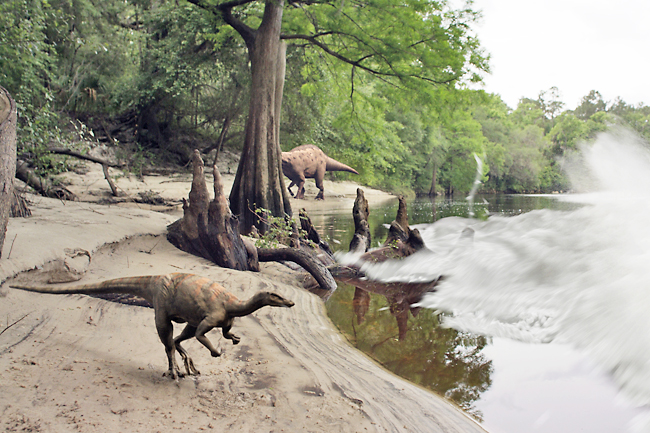Dave Kindy
THE WASHINGTON POST – The Thescelosaurus moved stealthily along the seashore.
Stretching about 12 feet long and weighing about 500 pounds, the thickly muscled dinosaur was probably looking for food – or trying to avoid becoming a meal.
Featuring prominent bony eyebrows and a pointy beak, Thescelosaurus plodded along on two feet with the bulk of its body leaning forward while a long tail stretched backward for balance.
Suddenly, the dinosaur lifted its head and looked around, alarmed as the calm was broken by a series of unnerving natural forces.
The ground started shaking with intense vibrations while water in the nearby sea sloshed about in response. The sky filled with burning embers, which drifted down and set fire to the lush primordial forest.
Thescelosaurus panicked and looked to flee – but it was too late. Everything changed in a heartbeat as a 30-foot-high wave of mud and debris came racing up the seaway from the south, sweeping away life and limb in the process.

The dinosaur was caught in the destructive deluge, its leg ripped off at the hip by the devastating surge.
That moment – 66 million years ago at the end of the Cretaceous period, when an earth-shattering asteroid ended the reign of the dinosaurs – is frozen in time today through a stunning fossil found last year at the Tanis dig site in North Dakota.
This perfectly preserved leg clearly shows the skin, muscle and bones of the three-toed Thescelosaurus.
While the details of the death scenario described above are embellished, they’re based on remarkable new findings and accounts by lead paleontologist at Tanis Robert DePalma.
“We’re never going to say with 100 per cent certainty that this leg came from an animal that died on that day,” the scientist said. “The thing we can do is determine the likelihood that it died the day the meteor struck.
“When we look at the preservation of the leg and the skin around the articulated bones, we’re talking on the day of impact or right before. There was no advanced decay.”
DePalma and the dinosaur leg will be featured in two episodes of Nova on PBS: Dinosaur Apocalypse: The New Evidence and Dinosaur Apocalypse: The Last Day.
Biologist and natural historian Sir David Attenborough will host the programmes, which were produced in conjunction with the BBC.
The leg and several other relics discovered at the North Dakota site are the first actual fossils found showing the death and destruction that took place when a 10-mile-long space rock struck the Yucatán Peninsula in the Gulf of Mexico.
This impact event 66 million years ago doomed the dinosaurs and led to the mass extinction of 75 per cent of animal and plant life on Earth.
At the time, the world was a much warmer place. There were no icecaps, and water levels were higher. The North American continent was split in two by the Western Interior Seaway.
Tanis is located on what was the edge of that massive river, which became a conduit of carnage after the asteroid struck.
The shock waves from nearly 3,000 miles away caused the seaway to erupt with a tsunami of epic proportions.
As DePalma pointed out, Thescelosaurus never stood a chance.
“You would not want to be there on that day,” he said.
“There was a turbulent wall of death heading up the river. In addition, all these glowing spherules are falling out of the sky.
“They’re like beads of superheated glass re-entering the Earth’s atmosphere after being ejected from the crater site at the Yucatán. Then there was all this seismic shaking. It was the end of the world.”
A dinosaur’s loss, though, is a paleontologist’s gain. After Tanis was discovered in 2008, scientists began to realise the fossils there were probably created during that impact.
Key discoveries were made, including the dinosaur leg, the embryo of a pterosaur still in its shell, a turtle pierced by a chunk of wood and the well-preserved skin of a triceratops.
Many of these fossils are being presented to the public for the first time in the PBS documentaries.
Perhaps most telling were the fossilised fish unearthed at the site in 2019, which caught many scientists by surprise.
In those petrified remains, researchers found the embedded evidence they needed to substantiate the claim that the animals died when the asteroid struck: the glass spheres, known as ejecta, that came raining down from the sky that fateful day.
“Those were fish that died on that day,” DePalma said. “We know that because they had ejecta from the impact in their gills.”
Researchers have unearthed countless samples of these glass spheres, all containing the signature chemical components of a major impact event.
Made up of sand and other materials, the molten glass was ejected into the atmosphere by the explosion caused by the asteroid striking the planet – estimated to be the equivalent of 10 billion atomic bombs.
Inside one of those circular fossils is a tiny speck of rock that may be from the killer asteroid itself.
DePalma has headed efforts at Tanis since 2012. He and other scientists on the team have published several major papers describing the discoveries and outlining the scientific methodology used to date the fossils and other evidence.








